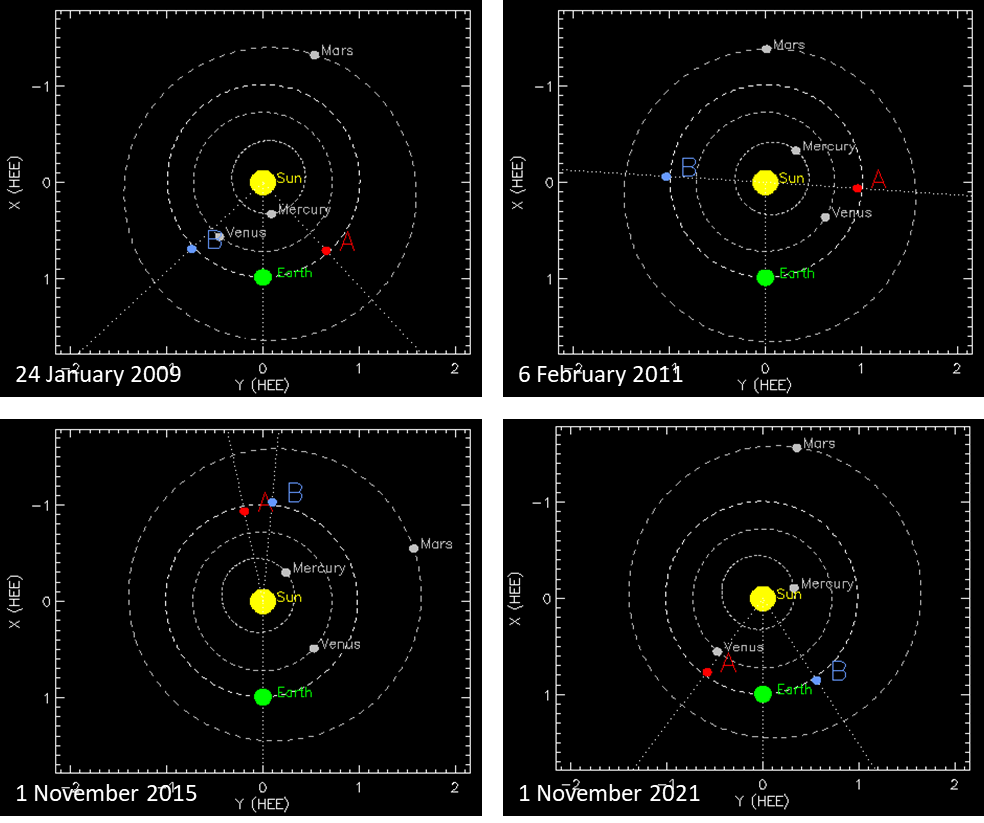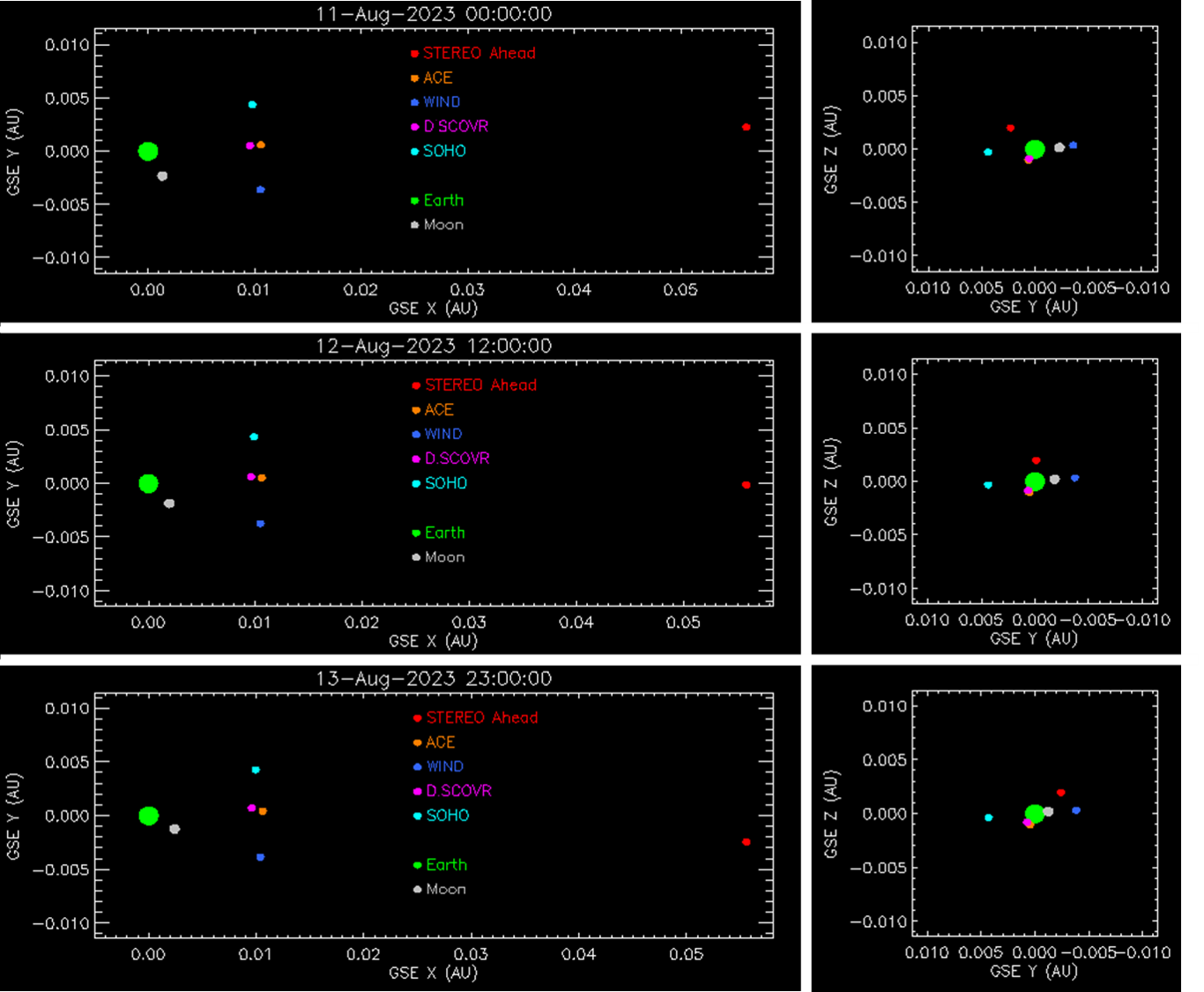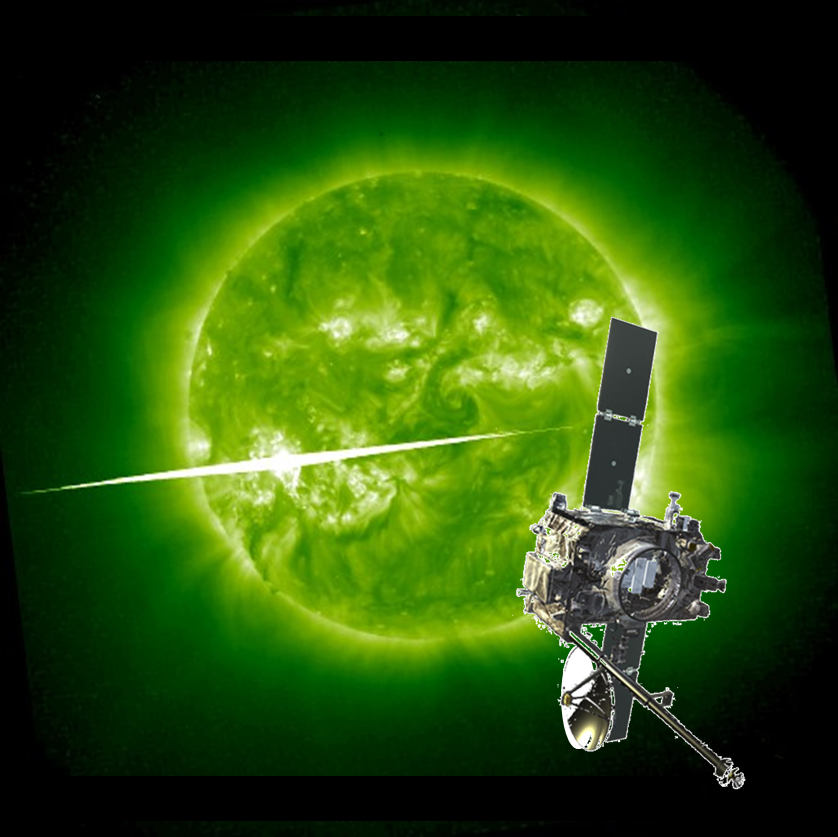Launched on 26 October 2006 (00:52 UTC), STEREO (Solar TErrestrial RElations Observatory) consisted of two nearly identical spacecraft: STEREO-A and STEREO-B. The spacecraft are at distances from the Sun respectively. slightly inward and slightly outward than the Earth's, and thus one of them is moving ahead of Earth in its orbit (STEREO-A), while the other is trailing behind (STEREO-B). Since their launch in 2006, both spacecraft gradually moved away from Earth, separating from each other at a combined rate of approximately 44° per year. They achieved 90° separation on January 24, 2009, a condition known as quadrature. On February 6, 2011, the two spacecraft were exactly 180° apart from each other, allowing the entire Sun to be seen at once for the first time (see this NASA newsitem). The maps underneath show the positions of the STEREO-A ("A") and -B ("B") relative to the "fixed" positions of the Sun (yellow) and Earth (green) during some of the mentioned key moments.

On October 1, 2014, contact was lost with STEREO-B during a planned reset to test the craft's automation, in anticipation of the solar "conjunction" period in 2015 (STCE newsitem). Telemetry revealed that the spacecraft was in an uncontrolled spin of about 3° per second, decreasing the amount of power that could be generated by the solar panels. Numerous attempts to re-establish permanent two-way communication between STEREO-B and Earth failed, and NASA ended the periodic recovery operations in 2018. Meanwhile, STEREO-A had passed its superior conjunction (i.e. on the opposite side of the Sun as seen from Earth) uneventfully, with no radio contact possible (and thus no data available) for several months from mid-March until mid-July 2015 (STCE newsitem) The angular distance between the two spacecraft and Earth was decreasing again, however with STEREO-A now trailing the Earth and the non-functioning STEREO-B preceding the Earth. To avoid confusion, the names were kept the same.

Celestial mechanics dictates that the spacecraft must return to near-Earth, and so this will be the case for STEREO-A in August this year. The STEREO-team has put a webpage online where the event can be tracked. On 12 August, the spacecraft will pass between the Earth and the Sun, in what is called an inferior conjunction. Closest distance to Earth will be just over 8.3 million km, far enough from the 1st Lagrangian point ("L1"), home of SOHO, ACE, DSCOVR and Wind, to safely pass. The graphs above show the position of the Earth, Moon (grey), STEREO-A and the 4 satellites at L1 on 11-12-13 August, as seen from above looking down on the ecliptic (the plane described by the Earth during its orbit around the Sun) with the Sun to the right (not shown). The 3 smaller graphs to the right show the positions of the same bodies for the same timings, but now seen in the plane of the ecliptic from behind the Earth (green) in the direction of the Sun. Distances are in Astronomical Units (1 AU is about 150 million km). After 12 August, STEREO-A will embark on another pass around the Sun's farside, again preceding the Earth during the next few years.

Credits: NASA/Goddard Space Flight Center/SwRI/STEREO/WIND
Over the years, STEREO has proven itself invaluable in solar science allowing an in-depth understanding of the 3D shape of coronal mass ejections (CMEs) and their propagation throughout the solar system. It also has instruments to measure the solar wind parameters, solar energetic particles, and to record solar radio bursts. This allows anticipation on solar wind structures, or cross-checking with near-earth or earth-based observations. Its EUV telescope (EUVI), coronographs (COR1 and COR2), and heliospheric imagers (HI 1 and HI 2) allow the observation of the sources of solar eruptions and also offer space weather forecasters a formidable tool in distinguishing the direction a CME is headed (see e.g. this STCE newsitem). In particular, provided sufficient separation with the Earth, when a halo CME is observed from Earth (in casu SOHO), the coronagraphic images from the STEREO spacecraft unambiguously establish the origin of the CME, i.e. either from the Sun's Earth-facing side, or from the Sun's farside. In the first case, the CME can impact Earth's magnetic field, in the other case the earth environment will not be affected. The imagery above (NASA/STEREO webpage) reveals the detailed features in a large geoeffective CME in December 2008, connecting the original magnetized structure in the Sun's corona all the way to its impact on the earth environment three days later (density measurements by the WIND spacecraft). At the time the data were collected, in late 2008, STEREO-A was nearly 45 degrees ahead of the Earth in its orbit, affording a very clear view of the Earth-Sun line. Further newsitems can be found on STEREO's newspage, and a retrospective on 10 years STEREO mission is here.






